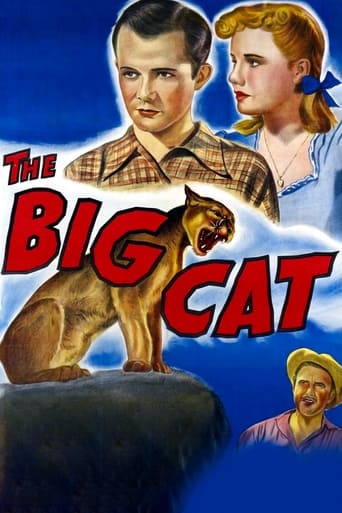dougdoepke
The movie's a quality outdoor production with engaging characters, solid script, and compelling scenery. So how did they get the cougar to go through his involved paces on apparent cue. The trainer or someone should get special credit since it's the cat's roaming that sparks the plot. Spindly city lad McCallister arrives in Utah high country complete with suitcase and city suit. The question is what to make of him since the native woodsmen are a tough lot, from the men to the boys. But tough as they are, they can't seem to take out the predatory cat that's taking their stock. Turns out that McCallister's related to grouchy Foster, but how he'll manage to fit in with his city ways is the big question. Good thing that sweet little malt-shop Garner's there to flounce her dress at him. I like the way the thoughtful screenplay sets events in Depression era 1930's. Among other things, it explains why McCallister moves from ravaged city to high country unknown.There's lots of outdoor action with no obvious sets. Note how noir director Karlson zeros in with close-ups to catch fleeting emotional moments, especially with Foster. Plus the chest butting between a blustering Foster and Tucker seems authentic as heck. But especially, there's that surprise about two-thirds way through that I sure wasn't expecting. I guess my only gripe amounts to a cougar without claws since Spike the dog is left unbloodied following his many tussles with the big cat. I guess the predator was understandably de-clawed before filming. Anyhow, I hope they gave the two critters a good payday for all their good work.All in all, I can see the movie being produced as a boy's matinée. After all horse and dog movies were very popular during the latter '40's. Nonetheless, the film's quality is really much better than most. In my book, the result happily qualifies as a guys-of-all-ages creation that's as entertaining now as it was in '49.
bkoganbing
The short-lived trans-Atlantic studio Eagle-Lion gave both the English and American moviegoers this Depression Era tale of a young man going to live in the wilds of Wyoming to escape the growing poverty and joblessness in Philadelphia where he's from. He's got an uncle there in Forrest Tucker, but goes to live with his mother's old boyfriend Preston Foster who has a place. Foster and Tucker aren't exactly best friends and living between both of them and trying to keep peace is preacher/farmer Irving Bacon and his wife Sarah Haden and their daughter Peggy Ann Garner. Of course she prefers McCallister to Tucker's oafish kids Skip Homeier and Gene Reynolds.It's bad times like every where else. There's a drought, but also a mountain lion eating stock everywhere. The government has put a bounty on the cougar and Foster wants to collect it as he could use the money to jump start his ranch with significant timber holdings. Of course so could everyone else use the bounty money in those troubled times.The film is in bad need of restoration to bring out the lush color location cinematography. But without any truly big names in the cast the film I'm sure is far down the pecking order. The cast gives some decent performances with McCallister and Garner a nice young couple the audience can identify with.When it's restored I'm sure The Big Cat will be fine family viewing.
FightingWesterner
A young easterner returns to the drought affected valley where his mother grew up, aggravating the already intense feud between his mother's ex-fiancé and his estranged uncle. Complicating things even more is a huge mountain lion that holds the small community virtually hostage, killing precious livestock.Though not exactly politically correct, this is an outdoor adventure with a whole lot of heart. A simple folksy script, earnest performances, and excellent location photography make this almost impossible to resist.With all the limited resources of a low-budget film in nineteen-forty-nine, director Phil Karlson managed to pull off a minor miracle by getting believable performances out of the animals.
wes-connors
Young Lon McCallister has trouble making ends meet in depression-era Philadelphia, so he returns to his dead mother's rural hometown. There, he becomes involved with the town folk's soap opera past, and catches the eye of Peggy Ann Garner. Due to drought, a menacing cougar is on the scene, making the outdoors very dangerous for the movie's characters...There is a lot of fighting, with and without the cougar; but, that's not the film's most interesting feature. More interesting is that the movie features a few "child stars" past their "Hollywood Prime." On hand: Lon McCallister, from 1943's "Stage Door Canteen" and others, Peggy Ann Garner from 1945's "A Tree Grows in Brooklyn" and others, Skip Homeier from 1944's "Tomorrow, the World" and others, and Gene Reynolds from 1938's "Boys Town" and others. Mr. Reynolds won huge fame later, as a producer ("M*A*S*H")."The Big Cat" and the family dog win big acting honors. **** The Big Cat (4/49) Phil Karlson ~ Lon McCallister, Peggy Ann Garner, Preston Foster, Forrest Tucker


